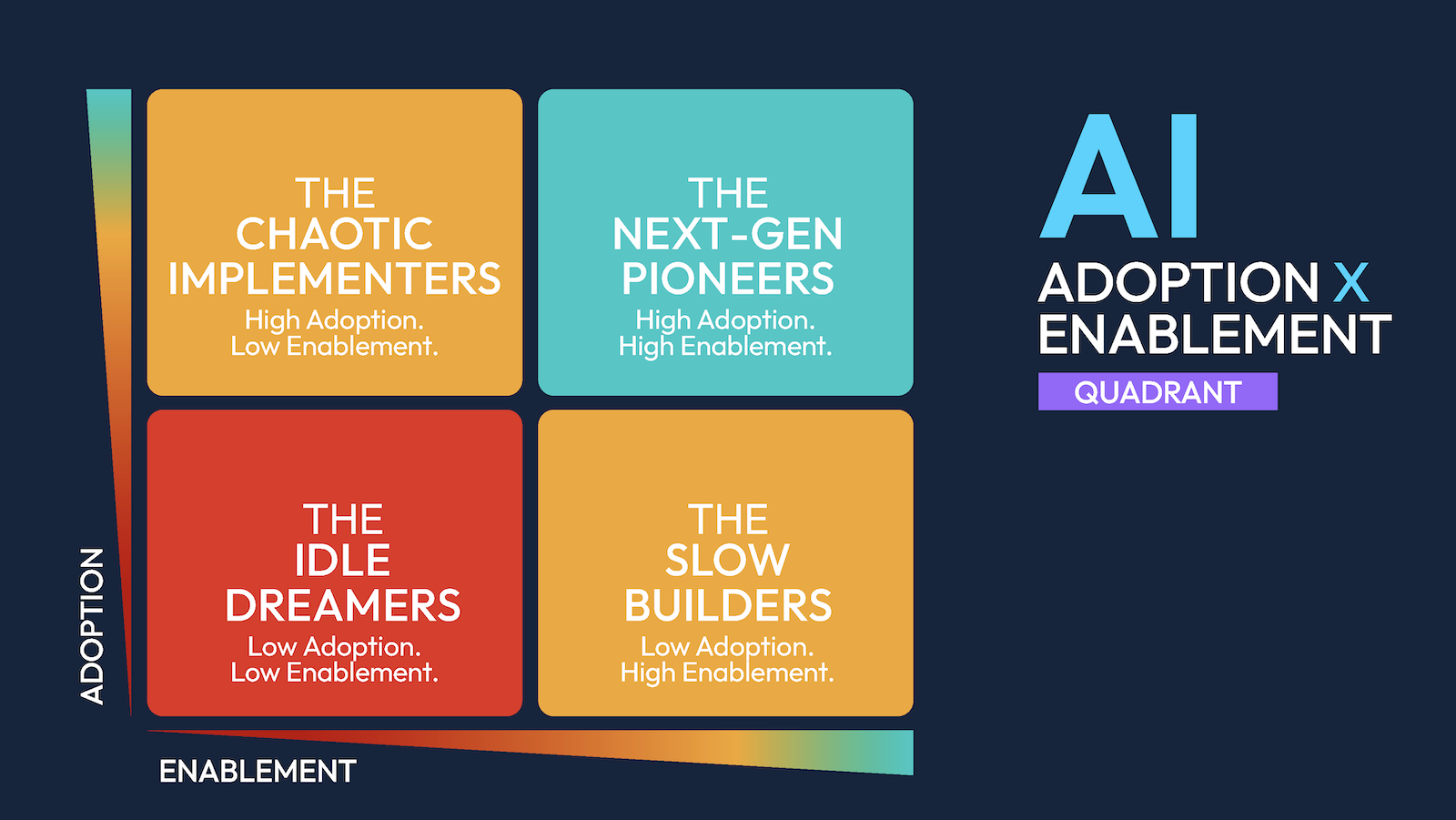As of July 2025 (and just a few hours after OpenAI launched the new ChatGPT Agent), it’s clear we’re in a new phase of workplace transformation. Yes, Gemini’s and Perplexity’s research agents are reducing research hours, and Bolt’s and Replit’s coding copilots are speeding up dev time. But make no mistake: humans are still needed. Not just to operate AI, but to instruct, question, and validate it.
That’s what this article is about: how your workforce can work with AI, not just around it.
While automation handles the grunt work like data entry, templated content, and scheduling, the true value frontier has moved. It now lies in the spaces where humans excel: judgment, creativity, empathy, and oversight.
In this new reality, the return on investment (ROI) isn’t just in faster machines. It’s in sharper minds.
That’s why a growing number of forward-thinking organizations are reallocating their learning and development (L&D) budgets toward human-centric upskilling. Not because it sounds good in a strategy doc. Because it drives real performance.
This piece unpacks that business case: grounded in data, rich with examples, and designed to help HR, L&D, and business leaders move from gut feel to budget line.

Why soft skills are not as “valued” as hard skills?
The Misconception: Why Human-Centric Skills Are Still Underfunded
Let’s start with the elephant in the training room:
Soft skills still get treated like soft returns.
Despite years of rhetoric around the importance of empathy, creativity, and communication, most organizations still prioritize technical or compliance training when budget season hits.
Terms like “leadership,” “innovation,” and “persuasive presentation” often get reduced to buzzwords. But we all recognize their absence when it matters most.
Think about when a leader fumbles a message, a team fails to think beyond old routines, or someone botches a stakeholder presentation. These moments highlight skill gaps that everyone feels, but few can quantify.
And the truth is, many organizations have been training for years, even decades, in these areas. Yet the needle hasn’t moved much.
Part of the issue is that the programs themselves may be stuck in time. Too often, soft-skills workshops rely on outdated slides, generic scenarios, and disconnected facilitation. They fail to account for how work has changed, how AI has shifted context, and how skills like emotional intelligence or strategic thinking now play out in hybrid, fast-moving environments.
In short, it’s not just what is being taught, it’s how it’s being taught.
We’ll explore that deeper in a future article. But for now, just know this:
Updating the training mindset is just as important as updating the budget.
Part of the problem is branding. “Soft skills” implies nice-to-have, nonessential capabilities. But what we’re actually talking about are the core capacities that make or break performance in the AI age.
The systems we use to measure training impact haven’t caught up either. We track completions, certificates, and headcounts, not capability development or decision-making quality. This gap between what we measure and what we value has led to a dangerous underinvestment in the very skills AI can’t replicate.
And that misalignment is already costing companies.

Are soft skills really that important?
What’s at Stake: The Strategic and Financial Risks of Underinvesting in Humans
The business risks of ignoring human-centric upskilling are real and growing. According to the World Economic Forum’s 2025 Future of Jobs report, 85% of employers say skill gaps are the biggest barrier to transformation. Yet most continue to underfund programs that develop precisely the skills needed in an AI-enabled workplace.
The problem isn’t just about capability. It’s about confidence. A study by BCG found a widening “AI Impact Gap”: while three-quarters of executives name AI as a top-three priority, only a quarter report significant returns. Why? Because they’re aiming low, optimizing isolated tasks instead of redesigning workflows around human-AI collaboration.
Meanwhile, the “Experience Gap” is eroding the leadership pipeline. As automation eats into entry-level roles, fewer employees are gaining the on-the-ground judgment and decision-making experience that used to define early career development. Add to this the “Leadership Perception Gap,” where frontline AI usage is reportedly 3x higher than executives believe, and you have a recipe for cultural disconnect, operational risk, and stalled adoption.
These aren’t abstract issues. They show up as missed KPIs, preventable errors, and lost talent.
Take, for instance, the product launch that stalled because cross-functional teams couldn’t align, or the frontline employee who mishandled a customer query due to lack of contextual judgment. These silent failures often trace back to underdeveloped human-centric skills—moments where better communication, empathy, or decision-making could have changed the outcome.
And the cost? It’s not just reputational. It’s financial, operational, and cultural. Emotional intelligence training alone has shown ROI figures as high as 1,484%, driven by lower attrition, higher engagement, and improved leadership effectiveness. If empathy, communication, and self-regulation can generate returns like that, it’s time we stopped calling them soft.

How can we effectively calculate the ROI of training?
The New ROI Math: From Course Completions to Capability Creation
“So Mav… how do you make the business case for something that doesn’t show up on a dashboard?”
SImple. You build a better dashboard.
Modern organizations are embracing a multi-layered ROI model that evaluates impact across four dimensions:
-
Productivity & Efficiency: AI-augmented employees complete tasks up to 25% to 55% faster. Training people to use and collaborate with AI tools dramatically increases throughput without burning people out.
-
Quality & Innovation: Upskilled employees produce higher quality outputs. At Deutsche Telekom, AI-powered coaching helped drive a 14-point NPS increase. In the Harvard/BCG study, teams using AI produced work that was 40% better in quality.
-
Human Capital Outcomes: Human-centric programs improve retention and engagement. Aviva doubled its engagement scores and cut complaints by 65% after rolling out a “double helix” AI-human workflow supported by 40,000+ training hours.
-
Financial Returns: When you layer these gains, including efficiency, quality, and retention, the math adds up. From MIT’s 250% ROI on soft skills training in manufacturing, to multi-million dollar savings in advisor turnover in finance, the data is increasingly hard to ignore.
The key is clarity. Frame the business outcome first, then connect the dots to the skills required. Don’t just propose a communication workshop. Instead, pitch a reduction in compliance errors or customer churn through better human-AI interaction. Speak the language of finance: NPV, IRR, payback period. Measure time-to-proficiency. Track error rates before and after training.
And if you can’t get the full budget, start with a pilot, prove the ROI, and scale from there.
By the way, all this is not just theory. Let’s look at how some organizations are already putting this model into action.

Learning from what worked.
Case Studies Done Right: What Rehumanizing Looks Like in Practice
The best proof doesn’t come from theory. It comes from organizations already doing this well.
Deutsche Telekom partnered with McKinsey to redesign its coaching process using AI. By creating personalized learning journeys for over 8,000 service agents and embedding training into daily workflows, they saw a 10% improvement in first-time resolution and a 2% drop in call transfers. Most importantly, the training didn’t happen in isolation. It was part of a performance transformation strategy.
How would this look like in your organization? Imagine a customer service lead, Elena, who struggled to provide targetted support to her team of junior agents. But with personalized learning journeys integrated into daily workflows, Elena could now see exactly where each team member needed coaching. This is also where our Thrive Coaching Mastery program comes in, where we marry proven coaching frameworks with the power of AI. Email noelle@radiant.institute if you would like to get a copy of the brochure.
Aviva, the UK insurance provider, rewired its claims journey around a “double helix” of automation and human oversight. They didn’t just deploy AI. They co-designed the system with employees and backed it up with 40,000 hours of training. Complaints dropped 65%, and the Net Promoter Score surged.
For Jerry, a senior in the operations, this meant his deep judgment was finally complemented, not replaced, by AI tools. Instead of spending hours fact-checking documents, Jerry could focus on complex issues and coach newer colleagues. And because he’s more into doing Meaningful Work instead of being stuck in Mundane Task, you get a happier, more fulfilled Jerry!
Amazon, through its $1.2 billion Upskilling 2025 initiative, is investing in internal mobility at scale. Rather than source future roles externally, it’s betting on building them from within by training 300,000 employees for roles of tomorrow.
What this means for Priya, a fulfillment center associate with no tech background? Well, she can now be upskilled in data analysis and cloud operations, on her way to be transitioned into a junior technical support role in the next few months.
These aren’t just L&D wins. They’re business transformations rooted in human capability.

Spending training dollars wisely
Strategic Reallocation: Where Smart Budgets Are Headed
Despite inflationary pressures, shrinking margins, and headcount freezes, smart organizations are making a key distinction: they’re not cutting L&D budgets. They’re reallocating them.
The latest 2025 data shows that while average per-learner spend has dropped globally, the most strategically minded enterprises are doubling down on human-AI fusion capabilities. In fact, 79% of these large organizations now consider human capability development the primary driver of AI investment—not an afterthought.
This trend aligns with BCG’s 10-20-70 rule: invest 10% in algorithms, 20% in tools and infrastructure, and a full 70% in people and process transformation. It’s a clear rebuke to tech-first thinking. Because let’s be real: if you’re spending millions on AI tools and nothing on enabling your people to use them wisely, you’re not innovating. You’re just “patching”.
This is also why in our AI Leadership Mastery programs, we spend sometime exposing leaders and managers to the AI Adoption X AI Enablement Framework, so they stay focus on being in the Next-Gen Pioneer quadrant.

The AI Adoption X Enablement Quadrant
And for CFOs watching every line item, here’s the bitter truth: hiring a new employee can cost 50% to 200% of their annual salary. Upskilling an internal hire is nearly always more cost-effective, and they’re more likely to stay. Plus, with an existing employee, you already know their work attitude and culture-fit. That’s something worth considering.
Frame that delta as a retention strategy and a cost-saving play, and suddenly your L&D budget moves from “nice-to-have” to “non-negotiable.”
Some firms are even quantifying this in terms of opportunity cost. For example, every month a team member remains underutilized due to lack of AI fluency translates to weeks of missed output, slower time-to-market, and increased reliance on external consultants.
The message is clear: AI may be the spark, but people are the fuel. Rehumanizing your workforce isn’t just the ethical path, it’s the economically sound one.

What we can do to make the change?
Implications for L&D and HR Leaders: Lead the Rehumanizing Shift
The future of HR and L&D isn’t course delivery. It’s capability design.
In this new role, you’re not a service provider. You’re a business enabler. You diagnose organizational bottlenecks, map the capabilities needed, and deploy training that actually moves the needle on retention, productivity, and innovation.
Take Sarah, a mid-level L&D leader at a global logistics firm, for instance. For years, her team ran compliance workshops and generic leadership programs with solid attendance but minimal impact. After a shift in strategy, Sarah reframed her team’s mission: from “training administrators” to “capability architects.”
Her first move? Collaborating with the product and operations teams to uncover a recurring issue: project delays tied to poor cross-functional communication. Rather than roll out another presentation skills course, Sarah led a co-designed learning sprint focused on decision velocity, stakeholder alignment, and persuasive communication in high-stakes environments.
Within 90 days, the pilot team reduced project bottlenecks by 28%. Suddenly, L&D wasn’t just delivering content. It was removing friction.
This is the shift. And it’s happening everywhere.
Forward-thinking L&D leaders are ditching vanity metrics in favor of outcome alignment. They’re treating training impact like product performance – tracking behavior change, error reduction, and time-to-proficiency. They’re leveraging internal data, running micro-pilots, and using the same A/B testing logic as product teams.
This doesn’t mean everyone needs a data science degree. But it does mean speaking the language of the business: understanding how better onboarding shortens time-to-productivity, how AI literacy reduces consultant spend, and how empathetic leadership improves retention in high-turnover functions.
It also means showing up differently.
Partner with finance to build ROI dashboards. Co-create with tech teams to embed AI fluency in workflows. Sit with frontline managers to understand where friction lives—and where capability gaps cost the most.
Because if HR and L&D don’t lead the rehumanizing shift, no one else will.

Investing in your organization’s greatest assets.
Conclusion: The Smartest Investment in the AI Era? Humans.
You can’t automate empathy. You can’t outsource ethics. And you can’t rely on AI to replace the very skills that make work human and valuable.
But you can train for them. You can measure them. And you can build an organization that thrives not in spite of AI, but because its people are prepared to collaborate with it.
The ROI of rehumanizing isn’t theoretical anymore. It’s visible. It’s quantifiable. And above all else, it’s urgent.
If AI is the engine of modern work, human capability is the steering wheel. Don’t remove the brakes to speed up. Invest in the drivers who keep it on course.
Looking back at the last few revolutions — computers, internet, social media, mobile devices — and you’d notice that the skills needed for each of those shifts are distinctive. The same will apply for the AI revolution. The difference is that for the earlier revolutions, we had a longer “gestation” period. But if you look at the pace in which AI is developing, you’d realize that speed is critical.
Plus, this might be a bus where if you were to miss, would be one that you can never ever catch up.
p.s. Talking about revolutions, are we using the training methods of the old and blindly applying it to the new, hoping that it will work? That’s a deeper conversation we will be having in an upcoming article, but if you are keen to look at how Radiant Institute approach L&D differently in the age of AI, drop us an email at noelle@radiant.institute.

Maverick Foo
Lead Consultant, AI-Enabler, Sales & Marketing Strategist
From Decision-Maker to AI-Orchestrator: Why Decision Fatigue Is the Hidden Cost of the Modern Workplace
Jun 29, 2025
Is it rewarding to have employees taking such initiatives to become more productive… or is the risk of security something to worry about?
AI in Coaching: Where Human Wisdom Meets Digital Precision
Jun 21, 2025
Is it rewarding to have employees taking such initiatives to become more productive… or is the risk of security something to worry about?
Middle Managers in the Age of AI: Overloaded, Underrated, and on the Edge of Reinvention
Jun 14, 2025
Is it rewarding to have employees taking such initiatives to become more productive… or is the risk of security something to worry about?
REACH OUT TO US
Fill up your details below, and we will get back to you A.S.A.P.!




0 Comments